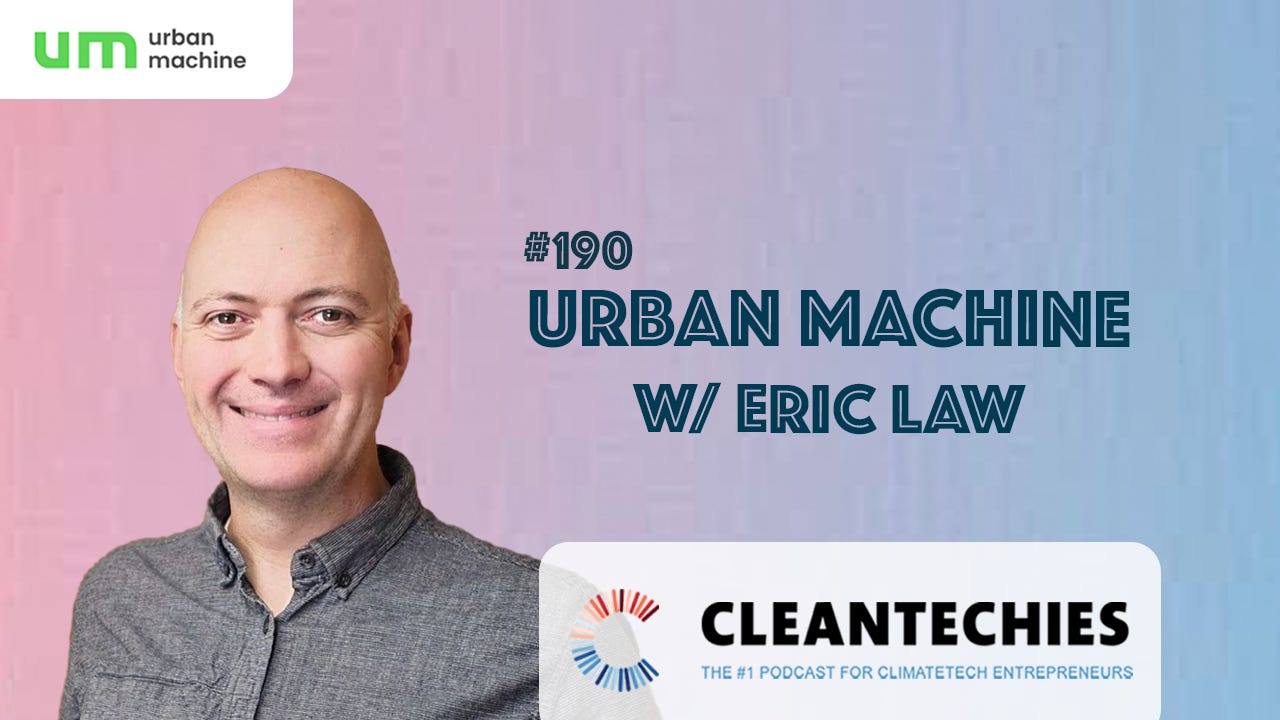Announcement
🚨🚨 ATTENTION 🚨🚨 CleanTechies has a new look 🚀
We’re entering a new chapter filled with huge steps forward for us as a group (one of which you’ll see in today’s episode 👀). We’ve upgraded our logo and design to match.
We’ll be explaining this & more in our first monthly show coming out at the end of July. Wanna stay tuned? Subscribe to follow along 👇🏽
Why did the tree go to the party?
Because It wanted to "branch" out!
🌎 Welcome back to CleanTechies, Founder edition.
We are The #1 Podcast For ClimateTech Entrepreneurs.
Each week, we publish 2x hour-long conversations with leading Founders, Investors, Operators, and Thinkers in ClimateTech to share their insights and tips for you.
On top of that, we publish other content like our Companies to Watch series, where we highlight early-stage startups operating in the spaces of our guests. That way, if you find yourself bullish on a space after an episode, you might find a deal you can chase!
Whether you’re an active ClimateTech Entrepreneur, an aspiring one, an investor, a service provider…if what you do touches supporting early stage climate tech, this is the place for you. Subscribe today.
Today, we are talking to Eric Law of Urban Machine.
🚨 Too busy to listen to the whole thing? We get it! That’s why we’ve included the text transcription at the end of this post - check it out 👇🏽
Reclaimed lumber is the superpower building material you’ve never heard of (because we’re all up to date on our Rolodex of sustainable building materials, right?).
Lumber, processed wood from trees, is a versatile and widely used building material known for its strength, durability, and workability.
So why isn’t there more of it in our buildings? Well, as great as lumber is, usable lumber from our buildings only comes from a few places — in the USA, it comes mainly from the Northwest and Southeast. That makes lumber an expensive building material.
But all hope is not lost. In comes Urban Machine. By creating reusable lumber from waste sites, they are increasing the supply of usable lumber, making it not only more available but more local.
Convinced that you should know more about this? Well, you’re in luck. Tune in to todays episode to learn more…🎧💡
📺 Watch on YouTube | 🍎 Apple Podcasts | 🎧 Spotify | 🗣️ Join the Slack Channel
Every ClimateTech Entrepreneur needs a reliable partner for their legal needs. Why settle for less than the best? 💪🏽
Reach out to Goodwin Law today; the law firm of choice for hundreds of ClimateTech Entrepreneurs worldwide. They have you covered from funding docs to offtake contracts to IPO and M&A support. GoodwinLaw.com (and tell them CleanTechies sent you!)
The Guest: Eric Law
Eric Law is the Co-Founder and CEO of Urban Machine
He spent his childhood spare time working on mini construction projects with his family (don’t you??)
With a background in construction and tech, Eric previously built and sold a SaaS company and led innovation programs for large contractors
His expertise spans mechanical engineering, construction technology, and sustainable solutions
At Urban Machine, he combines his experience to develop robotic systems that automate the removal of metal fasteners from reclaimed wood
The Company: Urban Machine
One Liner: Builds robots to reclaim and recycle lumber from construction and demolition waste
Urban Machine specializes in developing advanced robotic systems designed to automate the removal of metal fasteners from reclaimed lumber.
These robots use cutting-edge technology, including computer vision and AI, to identify and extract nails, screws, and other fasteners, transforming waste wood into reusable, high-quality lumber.
By making this process efficient and scalable, Urban Machine not only reduces construction waste but also provides a sustainable source of reclaimed wood for new building projects.
Got future guest suggestions or topics? Leave a comment!
Unable to support financially but still want to help? Share this post w/ 3 ClimateTech (or aspiring) entrepreneurs. Sharing is super helpful to us, and it costs you nothing.
📝 Show Notes:
Topics
03:14 Building Robots for Lumber
08:22 Removing Metal
18:30 Predicting Inventory
26:27 Challenges of Building a Hardware Company
28:47 The Economics of Construction
36:26 The Future of Urban Machine
40:35 Keys to Success in the Construction Tech Industry
Links
Connect with Somil on LinkedIn | Connect with Silas on LinkedIn
@Silas & @Somil_Agg on X
This podcast is NOT investment advice. Do your homework and due diligence before investing in anything discussed on this podcast.
Text Transcript 👇🏽
Somil Aggarwal:
Alright Eric, welcome to the show, how are you?
Eric Law:
I'm doing great. Thank you for having me on, Somil.
Somil Aggarwal:
Thank you for being on. For anyone who's tuning in via audio, Eric's background is a bunch of wood, which very much foreshadows what we're gonna talk about. Eric, don't leave the audience in suspense. Please, who are you?
Eric Law:
So I'm Eric Law, co-founder and CEO of Urban Machine. Urban Machine is about a two and a half-year-old robotics company, and we are building robots for reclaiming lumber from construction and demolition waste.
Somil Aggarwal:
Very, very easy problem to tackle, right? Super simple. It's why we've had like 10 lumber companies on this podcast, right?
Eric Law:
Haha exactly. Literally, we are building robots to pull nails. We are automating the crowbar essentially at its most basic step.
Somil Aggarwal: And it's like a full robotic arm. It's doing the whole thing?
Eric Law:
We've got arms, we've got cookers, we've got cutters. It's about a four-step process to get the metal fasteners out. Computer vision, AI, every piece of tech you can imagine, and it's about a 150-foot-long machine.
Somil Aggarwal:
So at the high level, if I understand this correctly, I watched a video of how you guys do it. You take basically a piece of wood that you want to recycle. They have these like giant metal screws that are still inside of the wood that you need to remove. And then you use a robotic arm to pull it out. Is that right?
Eric Law:
So there's actually two steps we do before. We've got the videos at the end effectors where we extract it. But for things like screws, long nails, we do kind of what we call a normalization process. We actually cut off all the extra metal. So you end up with just a little short nub sticking out of the wood and then we cook it. We heat it up until it's bright red, charring the wood that's holding those threads in place. And then we can extract a screw just like a nail. Just pull it straight out.
Somil Aggarwal:
Is that like, this might be a dumb question, but is it safe to be around the process when it happens? Is there any sort of fumes in that situation?
Eric Law:
It's just like a campfire. So we're charring wood, right? It's just like a campfire or any standard building structure fire. You know, a little bit of fumes come off of the fasteners depending on what they're coated with, but we exhaust that out. So we scrub it and exhaust it.
Somil Aggarwal:
That's so cool. How did you find this problem? Like, did you go from like, "Hey, I've exited the SaaS company. Let me walk around some construction sites because I'm bored." Like what led you there?
Eric Law:
After selling the SaaS company, I spent a couple of years with the company that acquired it, running their construction products portfolio. And then I left there and went to a large general contractor where I built an innovation program. We focused on solving the craft shortage problem in the field. The approach we took is you need labor to build buildings. We have a physical product. And robotics is the only tool in the tool chest to physically put material in place, aside from humans.
And so we worked with a lot of robotic startups on how to build buildings in the field, how to prefab material in factories, bring those prefab sections to the field, and reduce the amount of labor required because we just don't have enough people going into construction. And people want more housing and more buildings and stuff like that. And while I was there, I got involved with a sustainability initiative where we were looking at the waste streams. Our job sites were generating just tremendous amounts of waste. Think about shrink wrap and lumber and concrete and steel all coming off these job sites. And when we started digging into where it's going, that's where I learned that the wood was getting incinerated or buried in landfills. Nobody's recycling lumber coming off of job sites. And so it's like, okay, we recycle concrete, we recycle steel, why not lumber? Those are the three predominant structural materials. And it was the fasteners.
Just the labor involved to get the fasteners out was too difficult and you couldn't do anything with that lumber. You couldn't mill it, plane it, you couldn't feed it back in the lumber process with all these fasteners sticking out. And so anytime I come up with a process where it's highly repetitive, it's dull, it's dangerous, it takes a lot of labor, all right, that's a solution that robots are doing really well at. They love to repeat the process over and over.
Somil Aggarwal:
That's amazing. And I feel like we kind of jumped a couple of steps ahead because it's hard not to talk about how cool the tech is. So you were sort of in the space looking at, it doesn't sound like you were necessarily looking at it from a sustainability point of view, sort of an innovation point of view, looking at the waste streams of construction. And you saw these fasteners.
So fasteners like this metal in the wood, essentially, from previous construction projects likely, right?
Eric Law:
It was about holding the building together, temp structures, concrete formwork. They all use nails, screws, staples, the three predominant fasteners we run across. And we were looking at it from a cost perspective and a sustainability perspective. You know, what is all this waste? How do we reuse it?
Somil Aggarwal:
And why, I'm gonna use your wording here, why do you cook screws?
Eric Law:
So if you ever try and pull a screw out of a piece of wood with a pry bar, one, it's incredibly hard, and two, if it does come out, it tends to shear, where you leave the threaded part in the wood. Screws are phenomenal with holding force and the ability to hold multiple pieces of wood together. And so by cooking it, we're charring the wood and essentially breaking down those fiber bonds that hold the fastener in place. And then it slips out just like a nail. To remove a screw takes hundreds of pounds of pull force if you're pulling straight out. After we cook it, 10 to 20 pounds of pull force.
Somil Aggarwal:
Wow, so it's more or less just making it, is it looser? Like how would you think about it?
Eric Law:
I mean, if we overcook them, they fall out. We can cook it so long where you can char the wood, where you shake the wood and the fastener will fall out. But we found about 45 seconds of cook time is perfect. Give it a light tug and out it comes.
Somil Aggarwal:
Okay, so now you have this ability to cook the screws, build this robotic arm, and take it out. We joked about this. You gotta tell me, how in the world do you get a robotic arm from this idea in your head to a robotic arm in front of you?
Eric Law:
A lot of testing in the lab. And before that, I partnered up with some really great folks. So my co-founders Andrew Gillies and Alex Steele, I pitched them on the idea. Andrew and I had done some research on other robotics projects before. Andrew's background is agro robotics, industrial robotics. Super sharp guy. And I said, hey, I got this problem. Could we automate with robots? And he's like, absolutely. He's like, we could totally do this. And so within about a month or so, he built the first prototype where he was using a webcam to pull nails out of a piece of two by four. And that's how we ended up closing the first round of fundraising as we took it down the road, showed it off to some investors and they were like, we'll invest in these guys. And Andrew knew Alex before he's like, I know this really sharp computer vision AI guy that we got to bring on the team. And so that's how the three of us got together and formed Urban Machine back in October of 21.
Somil Aggarwal:
Nice, you got the eyes, the brawn, and the wood guy. Essentially, where do you put yourself in that puzzle?
Eric Law:
Exactly. I'm the construction. I'm the one that's out trying to sell this thing and get the customers on board and fundraising. They take care of the hardware and the software and the AI and make the magic work.
Somil Aggarwal:
How do you, I'm curious, like, so you've built this team together. Someone, you know, one of them clearly has previous robotic experience, and then there's the vision component, which is, so how many understand this? Is this under looking at the nails in the wood? Like, are you trying to identify nails in the wood? Like, how much of a vision technology are you doing?
Eric Law:
The computer vision is set up to identify the location of the fasteners, the type of the fasteners, and then we use that for the extraction process. Because you want to understand the orientation of the fastener in order to extract it. And so we do all that with computer vision. We’ve trained our own models. And keep in mind, over the last 100 years, a lot of different fasteners have been used. Everything from tiny little nails for lath and plaster siding to big nails for concrete formwork, screws, all different shapes and sizes of screws. The key thing is, how do you handle essentially this unknown material? You have no idea. You’re just feeding this machine lumber and it’s got all these fasteners in it. We’ve got to be able to get them all out every time. And so that’s what this multi-step process is for, to ensure that using a combination of muscle, cutting, cooking, technology, computer vision, and extraction with this robotic end effector, it becomes metal-free by the end of the line.
Somil Aggarwal:
So there’s both the identification, you have to pull it out, and you’re basically surveying the whole piece of wood just to detect these imperfections. And so now let’s say you have a completed piece of wood, you’ve grabbed it, removed it, how are you handling that wood to send it to essentially its next building, its next wall to record a podcast behind?
Eric Law:
Once it’s metal-free, then it becomes a bunk of lumber, just like virgin lumber, and heads on the flatbed trucks. Before our process, we call it the prickly pear state. It’s full of nails and everything sticking out, so we have to handle it with special mechanisms and special systems. But once it comes out the other end, you can run it on a conveyor, standard rollers. You can load it up on racks, standard flatbed trucks. It’s ready to roll as a 2x4, 2x6, and go back in that lumber ecosystem.
Somil Aggarwal:
Are you fighting a perception problem? Do people look at your reused lumber any differently?
Eric Law:
Anyone who knows anything about wood knows our reused lumber is actually higher quality than the new stuff that you get. It’s one of the very few products because the trees that we harvested 50 years ago, 75, 100 years, the farther back you go, they were allowed to grow longer in nature. Today, everything’s coming off of farms. We’re in second, third, fourth growth forests, depending on what you’re harvesting. Those tree farms typically harvest smaller, faster-growing trees, so they have wider grains and are grown for speed. It’s not as high quality as what you got 100 years ago, even 50 years ago. We’re bringing to market a recycled product that’s higher quality than the stuff you get at your lumber yard today.
…Tune into the episode for the rest 🎧💡



















#190 Climate Robotics, Reusing Lumber, the Economics of Construction, Inventory Prediction, & More w/ Eric Law (Urban Machine)